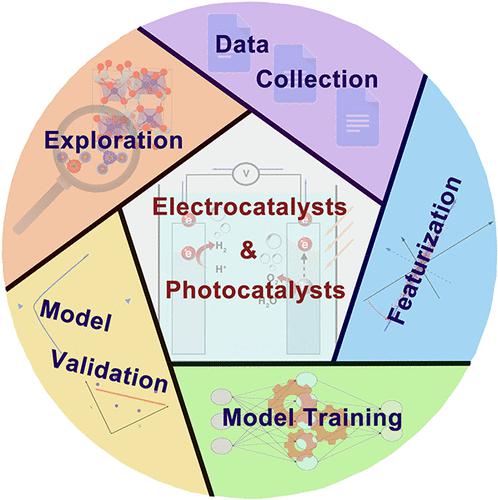当前位置:
X-MOL 学术
›
Chem. Rev.
›
论文详情
Our official English website, www.x-mol.net, welcomes your
feedback! (Note: you will need to create a separate account there.)
Machine Learning for Electrocatalyst and Photocatalyst Design and Discovery
Chemical Reviews ( IF 51.4 ) Pub Date : 2022-07-21 , DOI: 10.1021/acs.chemrev.2c00061 Haoxin Mai 1 , Tu C Le 2 , Dehong Chen 1 , David A Winkler 3, 4, 5 , Rachel A Caruso 1
Chemical Reviews ( IF 51.4 ) Pub Date : 2022-07-21 , DOI: 10.1021/acs.chemrev.2c00061 Haoxin Mai 1 , Tu C Le 2 , Dehong Chen 1 , David A Winkler 3, 4, 5 , Rachel A Caruso 1
Affiliation

|
Electrocatalysts and photocatalysts are key to a sustainable future, generating clean fuels, reducing the impact of global warming, and providing solutions to environmental pollution. Improved processes for catalyst design and a better understanding of electro/photocatalytic processes are essential for improving catalyst effectiveness. Recent advances in data science and artificial intelligence have great potential to accelerate electrocatalysis and photocatalysis research, particularly the rapid exploration of large materials chemistry spaces through machine learning. Here a comprehensive introduction to, and critical review of, machine learning techniques used in electrocatalysis and photocatalysis research are provided. Sources of electro/photocatalyst data and current approaches to representing these materials by mathematical features are described, the most commonly used machine learning methods summarized, and the quality and utility of electro/photocatalyst models evaluated. Illustrations of how machine learning models are applied to novel electro/photocatalyst discovery and used to elucidate electrocatalytic or photocatalytic reaction mechanisms are provided. The review offers a guide for materials scientists on the selection of machine learning methods for electrocatalysis and photocatalysis research. The application of machine learning to catalysis science represents a paradigm shift in the way advanced, next-generation catalysts will be designed and synthesized.
中文翻译:

用于电催化剂和光催化剂设计和发现的机器学习
电催化剂和光催化剂是可持续未来的关键,它们可以生产清洁燃料、减少全球变暖的影响,并为环境污染提供解决方案。改进催化剂设计过程和更好地理解电/光催化过程对于提高催化剂有效性至关重要。数据科学和人工智能的最新进展具有加速电催化和光催化研究的巨大潜力,特别是通过机器学习快速探索大型材料化学空间。这里提供了对电催化和光催化研究中使用的机器学习技术的全面介绍和批判性评论。描述了电/光催化剂数据的来源和当前通过数学特征表示这些材料的方法,总结了最常用的机器学习方法,并评估了电/光催化剂模型的质量和效用。提供了机器学习模型如何应用于新的电/光催化剂发现并用于阐明电催化或光催化反应机制的说明。该评论为材料科学家选择用于电催化和光催化研究的机器学习方法提供了指南。机器学习在催化科学中的应用代表了先进的下一代催化剂设计和合成方式的范式转变。以及评估的电/光催化剂模型的质量和实用性。提供了机器学习模型如何应用于新的电/光催化剂发现并用于阐明电催化或光催化反应机制的说明。该评论为材料科学家选择用于电催化和光催化研究的机器学习方法提供了指南。机器学习在催化科学中的应用代表了先进的下一代催化剂设计和合成方式的范式转变。以及评估的电/光催化剂模型的质量和实用性。提供了机器学习模型如何应用于新的电/光催化剂发现并用于阐明电催化或光催化反应机制的说明。该评论为材料科学家选择用于电催化和光催化研究的机器学习方法提供了指南。机器学习在催化科学中的应用代表了先进的下一代催化剂设计和合成方式的范式转变。该评论为材料科学家选择用于电催化和光催化研究的机器学习方法提供了指南。机器学习在催化科学中的应用代表了先进的下一代催化剂设计和合成方式的范式转变。该评论为材料科学家选择用于电催化和光催化研究的机器学习方法提供了指南。机器学习在催化科学中的应用代表了先进的下一代催化剂设计和合成方式的范式转变。
更新日期:2022-07-21
中文翻译:

用于电催化剂和光催化剂设计和发现的机器学习
电催化剂和光催化剂是可持续未来的关键,它们可以生产清洁燃料、减少全球变暖的影响,并为环境污染提供解决方案。改进催化剂设计过程和更好地理解电/光催化过程对于提高催化剂有效性至关重要。数据科学和人工智能的最新进展具有加速电催化和光催化研究的巨大潜力,特别是通过机器学习快速探索大型材料化学空间。这里提供了对电催化和光催化研究中使用的机器学习技术的全面介绍和批判性评论。描述了电/光催化剂数据的来源和当前通过数学特征表示这些材料的方法,总结了最常用的机器学习方法,并评估了电/光催化剂模型的质量和效用。提供了机器学习模型如何应用于新的电/光催化剂发现并用于阐明电催化或光催化反应机制的说明。该评论为材料科学家选择用于电催化和光催化研究的机器学习方法提供了指南。机器学习在催化科学中的应用代表了先进的下一代催化剂设计和合成方式的范式转变。以及评估的电/光催化剂模型的质量和实用性。提供了机器学习模型如何应用于新的电/光催化剂发现并用于阐明电催化或光催化反应机制的说明。该评论为材料科学家选择用于电催化和光催化研究的机器学习方法提供了指南。机器学习在催化科学中的应用代表了先进的下一代催化剂设计和合成方式的范式转变。以及评估的电/光催化剂模型的质量和实用性。提供了机器学习模型如何应用于新的电/光催化剂发现并用于阐明电催化或光催化反应机制的说明。该评论为材料科学家选择用于电催化和光催化研究的机器学习方法提供了指南。机器学习在催化科学中的应用代表了先进的下一代催化剂设计和合成方式的范式转变。该评论为材料科学家选择用于电催化和光催化研究的机器学习方法提供了指南。机器学习在催化科学中的应用代表了先进的下一代催化剂设计和合成方式的范式转变。该评论为材料科学家选择用于电催化和光催化研究的机器学习方法提供了指南。机器学习在催化科学中的应用代表了先进的下一代催化剂设计和合成方式的范式转变。











































 京公网安备 11010802027423号
京公网安备 11010802027423号